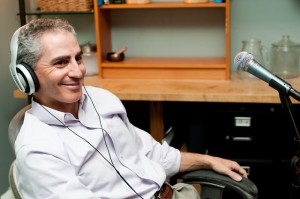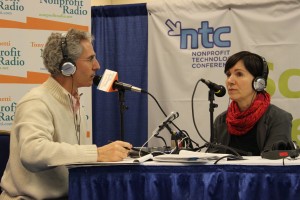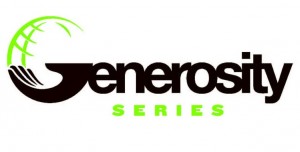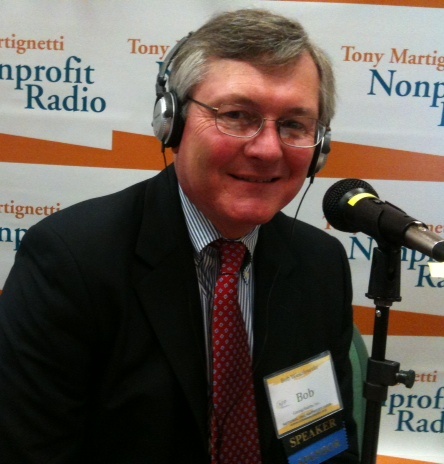Board relations. Fundraising. Volunteer management. Prospect research. Legal compliance. Accounting. Finance. Investments. Donor relations. Public relations. Marketing. Technology. Social media.
Every nonprofit struggles with these issues. Big nonprofits hire experts. The other 95% listen to Tony Martignetti Nonprofit Radio. Trusted experts and leading thinkers join me each week to tackle the tough issues. If you have big dreams but a small budget, you have a home at Tony Martignetti Nonprofit Radio.
View Full Transcript
Transcript for 654_tony_martignetti_nonprofit_radio_20230821.mp3
Processed on: 2023-08-18T14:09:26.968Z
S3 bucket containing transcription results: transcript.results
Link to bucket: s3.console.aws.amazon.com/s3/buckets/transcript.results
Path to JSON: 2023…08…654_tony_martignetti_nonprofit_radio_20230821.mp3.166430116.json
Path to text: transcripts/2023/08/654_tony_martignetti_nonprofit_radio_20230821.txt
[00:00:35.76] spk_0:
Hello and welcome to tony-martignetti Nonprofit radio. Big nonprofit ideas for the other 95%. I’m your aptly named host of your favorite Heb Mittal podcast. And oh, I’m glad you’re with us. You’d turn me into a mono. Thus, if I had to see that you missed this week’s show. Here’s our associate producer, Kate with what’s coming?
[00:00:59.48] spk_1:
Thank you so much, tony. We have the five A is an awesome fundraising. It’s a valuable back to basics conversation with a bunch of tips. You’ve probably never heard leading us thorough is Kara Augsburger from Donor box on Tony’s take two.
[00:01:02.29] spk_0:
It could have been the end for me,
[00:01:12.22] spk_1:
were sponsored by donor box, outdated donation forms blocking your supporters, generosity, donor box, fast, flexible and friendly fundraising forms for your nonprofit donor Boxx dot org.
[00:01:21.65] spk_0:
I love that. I love that alliteration. Kate, fast, flexible, friendly fundraising forms, love that.
[00:01:29.32] spk_1:
It sounds cool, but it’s not very fun to say
[00:01:34.42] spk_0:
tough,
[00:01:37.39] spk_1:
very tough. Now, here is the five A’s of awesome fundraising.
[00:02:08.04] spk_0:
It’s a pleasure to welcome Kara Ox Beger to nonprofit radio. She is a longtime development professional, currently serving as fundraising coach for donor Boxx and focuses on consulting with nonprofits of all sizes. Her expertise is in coaching, annual fundraising, project management and communications. She’s on linkedin Kara Ger with A P, not A B. It’s not.
[00:02:14.32] spk_2:
No, it’s not tony
[00:02:18.75] spk_0:
and the company is at donor box dot org. That’s correct.
[00:02:22.03] spk_2:
Thanks, tony. Thanks so much for having me. What a warm welcome pleasure.
[00:02:26.13] spk_0:
Pleasure to have you from Noblesville, Indiana.
[00:02:29.41] spk_2:
That’s correct.
[00:02:30.90] spk_0:
And we’re talking about the five A’s of awesome fundraising. So this is not just, this is not just, you know, lackluster, mediocre type fundraising. We’re talking about awesome fundraising,
[00:02:46.79] spk_2:
right? The five A S, you know, our donor box team coined the term the five A’s of awesome fundraising to really introduce the concept and help people remember the cycle of fundraising. So, you know, identify, cultivate, solicit steward, we just made them a little easier and put an a next to each of them. So we have, it’s
[00:03:22.00] spk_0:
the cycle that we’re accustomed to. Exactly. But all right. So refreshers are important, valuable basics, basics, lots of people trigger, you know, they’ll say, oh, you know, that’s just a good reminder, good reminder. So we’re gonna, we’re gonna share good reminders. Excellent, excellent. So, uh I’ll let you introduce your, your first. A
[00:04:21.71] spk_2:
Well, sure. So we often at donor box, we are working with fundraisers who are really, really good at delivering on their mission. They’re really, really good at um creating innovative programs, but maybe they’re struggling to understand some fundraising fundamentals. And so my job is to kind of create ways to make learning those fun and engaging. And so that’s was the basis around the five A’s. So first we attract new supporters to your organization, you know, that would be identi identification and cultivation and then we ask them to come alongside you by giving, then we promptly acknowledge those gifts, right? And then we account for those donations and we do it again and again and again. So it’s attract, ask acknowledge account. And again, so those five A’s, they’re not fancy, they’re not innovative, they’re nothing new. Um But those are kind of those fundraising fundamentals that successful nonprofits are actively doing and actively incorporating into their communication cadence to bring donors into the life of the organization and really cultivate that sense of belonging.
[00:04:40.93] spk_0:
All right. So let’s, let’s focus on attraction. Yeah. What, what uh what are your reminders there, your tips.
[00:04:51.46] spk_2:
So, you know, you, you need to attract new supporters to your organization and then you need to make sure that your organization is attractive to those. So, uh you want to make sure that you are um actively on social media that you’re telling compelling stories of your mission and action, you’re showing people ways to get involved by volunteering and things like that. So you’re attracting those people, you’re, you know, the fundraising fundamental. So you’re cultivating them to your organization
[00:05:31.48] spk_0:
and some of those uh some of those uh a attraction mechanisms might be as simple as, like, sign a petition. Absolutely. Yeah. I mean, it doesn’t have to be come in person or something. We can, we can have, we could have a lift but something that gets people uh initially
[00:05:34.05] spk_2:
engaged. Yeah. You’re aware, you’re building awareness for your organization. Yeah.
[00:05:38.95] spk_0:
OK. That’s another good a but that’s not in awareness. It’s like a subset. So, uh I’m not, I don’t want to pervert the whole donor box. Uh the whole donor box. A team of five A make it six.
[00:05:49.76] spk_2:
We don’t want no.
[00:05:50.75] spk_0:
Every time you say an A word, I’m not gonna say, oh, there’s an A but uh awareness is a subset of attraction and being, being attractive. Talk a little more about the, the being attractive part how you, you know, how you appeal.
[00:06:37.23] spk_2:
Yeah. So you know, you repeat the cycle and you want to keep your organization attractive to your current supporters. So maybe that’s where you introduce a survey or you ask what appeals to them most about the mission. You could uh engage with them through some newsletters, some good communication about what’s going on or, you know, in person. So you can invite them to coffee, invite them to events, invite them to volunteer. Um And it’s not just about doing those things, it is about staying relevant in the minds of your supporters. You know, we know supporters are supporting fewer organizations these days, dollars are limited. And so you really want to stay in the forefront of your supporters’ minds. And so that’s where you really just want to keep that communication cadence. Um going throughout the year, you don’t want to just go, go to your donors when you need something, you want to communicate and build relationship and stay in relationship with them.
[00:07:05.75] spk_0:
Yeah, that is critical. Not only sending solicitations, you know, however many times a year, let’s drill down, let’s drill down a little bit on the, uh, the surveys, surveys. What, what’s your advice around survey? You know, like length? Um, I don’t know, time of year, uh, how to get folks to do the survey, you know, what, what are your tips around those things?
[00:07:53.68] spk_2:
You know, I think my, uh, my advice to anyone is as, um, personal of the ask as you can make it. I think the more, um, engagement you’re going to get around it. So if you could say, hey, tony, I’m gonna send you a survey in the mail or in the, you know, in your email. And if you have five minutes to really give me some insight into what you see, you know, in the organization, boy, I would really value that if I could ask you that on the phone or if I saw you at an event or something like that, you might be more engaged and more apt to complete that survey. So, that, you know, and you can even personalize that at a scalable level through some emails, some make your email look really personal through some mail merges and things like that to really make it seem like you’re speaking one on one to the receiver. So that’s how, that’s an
[00:08:20.22] spk_0:
introductory email. Yeah. Yeah, couple of days I’m going to send you or something
[00:09:13.79] spk_2:
like that or, yeah, I mean, just however the communication, the communication schedule works out for you, you could even, you know, package it together with the survey link or something like that. But yeah, just as, as interpersonal as, as, as possible. So it looks less like it’s from the organization and more from the person who’s sending it, whether that’s the executive director or the communications manager, the development manager, whatever it is. So I think that one on one really feeds engagement. Um, but as far as like length, what we’re seeing that is working really well is micro content so short, actionable. Um, you know, I think if people see how far along they are and in the steps, you know, you’re at step one of five, question, one of five, something like that. That kind of keeps people motivated to complete it as opposed to this never ending survey that, that never ends. I know, I know,
[00:09:14.86] spk_0:
I appreciate the progress bar. You’re 10% or 20% or right, one out of five or something. I like to know that I like to know where the end
[00:10:31.15] spk_2:
is. Yeah. Yeah, absolutely. And I think if you have um, well crafted questions, so you’ve worked with, you know, a board member or your staff ahead of time to determine what is, what’s your outcome on this survey? What do you really want to glean from this information? I’m working, I’m on the board for um, a nonprofit here in uh the Indianapolis area that works um to provide um services to people who are a little food insecure. Um But the foundation, so there’s a foundation that’s set up to, to kind of um resource the food pantry and, and the services. So there’s some confusion right now on, do I give to the church that runs the services or do I give to the foundation or whatever? So, what we’re doing is we’re crafting a survey to say, hey, do you understand the difference between the foundation, the church, the food pantry? How does that work? Um And, and really trying to get to the purpose, our purpose is clarity around our communication and where to direct people to give money, but we need to work backwards and craft the questions so that they really are um short and compelling and impactful and give us the answers that we need. So I think as long as you’re, you’re really paring down um and really honing in on the purpose of the survey, I think you’ll be able to, to draft some short, uh, really, really great questions that’ll, that’ll drive the, the answers that you’re looking for.
[00:10:56.06] spk_0:
You have a maximum number of questions that, that you’re working toward in your survey.
[00:11:13.30] spk_2:
I’d like to stop it. I’d like to leave it at five. I think five is a good number. Um, you know, I think if they’re quick questions, if it’s multiple choice, those would go a little faster than those open ended. So maybe you’d have a little more wiggle room for some questions there. But I think, you know, too, I think there’s always an opportunity for an executive director or someone to step in after you complete the survey and say, hey, tony, those were really great um examples you shared in that survey, would you be open to a conversation to talk a little bit more about what you think and you know, those opportunities, those touch points are really part of those five A’s, you’re keeping that conversation going and saying, I see you and I value the input that you have into our organization.
[00:11:41.30] spk_0:
I think people would be very grateful for like personal follow up. Now, if you’re, you’re sending thousands of surveys, you know, I don’t know. Uh hopefully you get more than a dozen responses. Sometimes surveys can do poorly. So you might, you might only get 12 or 15 or 20 responses and then you can be personal um with, with those, with those folks and look, I mean, you’re thanking them in a way for, you know, for being among the small percentage of people who did reply.
[00:12:09.52] spk_2:
Oh, for sure, for sure. And what, what’s the, what’s the old adage that you ask for it? You ask for money and you get advice, but you ask for advice and you get money. Well,
[00:12:19.67] spk_0:
that, that may result indeed. Or you, or you might, you might get a, a new volunteer or something. You’ll, you’ll certainly get somebody grateful. Uh, after you’ve, you’ve, like, personally followed up and said, you know, your answer to this was important or
[00:12:32.16] spk_2:
whatever. Yeah. It’s an opportunity. It’s an opportunity for conversation, an opportunity to grow that relationship.
[00:12:58.25] spk_0:
Another thing, um, folks have said is that you don’t ask for information that you, uh, you can’t preserve and, and act on like, if, like, if you’re asking a survey question, would you rather we email you or use direct mail or text? Then they give you the answer. You have to, you have to honor their, their answer. Either that or don’t, don’t ask the question. Yeah,
[00:13:14.38] spk_2:
exactly. Yeah. Yeah. If you’re not gonna segregate that information into your data and you end up mailing someone who said they only want an email, then it may have backfired on you the whole process, right? You really,
[00:13:17.36] spk_0:
yeah, then you have hurt the, then you hurt the relationship better to not even just ask if you don’t have the capability for text. Don’t offer communications, you know, by, by
[00:13:26.08] spk_2:
MS for sure, it goes back to the whole big, big goal that what outcome do you want from the survey?
[00:13:33.26] spk_0:
Absolutely. Very true. As you said at the outset, right? All right. Uh You feel OK with uh attract and being attractive?
[00:14:15.40] spk_2:
Yeah, I think so. I think, yeah, identify and cultivate and um really get them introduced into all that your organization offers. So that is a track. OK. Then you’re ready to ask. Oh, you are ready to ask. And I think so many nonprofits think that that ask is exponentially um hard and it’s an exponential, you know, use of time in fundraising. But really if you’re doing these other things, well, that ask gets a lot easier, but it, it is important to ask and if you are only telling, you know, stories of impact and um you know, really advocating for your cause, but you never ask for money, you’re missing a big opportunity there.
[00:14:23.10] spk_0:
Now you ask, could come in other forms too, right? It might be. Now, now we’re talking about something more than, you know, sign a petition, but it could be volunteer.
[00:15:14.76] spk_2:
Mhm Absolutely. Yeah. Absolutely. One pitfall I see with that though, tony is um a lot of times in a fundraising appeal, I think we sometimes as nonprofit professionals are kind of uncomfortable about that ask and what we tend to do is gloss over it in the fundraising appeal. So, hey, tony. Can you give me $50 or volunteer or share this email? I think it’s really important in a fundraising appeal to have one call to action and if you’re asking for money and for a volunteer and to share the word, guess what people are going to do, the one thing that doesn’t cost them money. So if you’re asking for money, make sure that that’s super clear. And that is the only call to action in your, in your fundraising appeal.
[00:15:47.97] spk_0:
Yeah, I, I didn’t mean to dilute your, your, your, your fundraising. Ask if I was just saying, you know, you could be asking for something else that’s substantial, which is a gift of time. Yeah. But no, I absolutely agree. You don’t dilute, don’t and don’t be humble. You know, you, oh, you know, we hate to ask. But could you, you know, you have, needs, your work is important and you have, needs to, to fulfill that work, to fulfill that mission. Ask with
[00:15:48.71] spk_2:
confidence. Right. Absolutely. Absolutely. Um Fear free fundraising is, is kind of the approach I take there. You, you need to know what you do, why you do, why it’s important, um, what you’re doing differently than anyone else and be really, really proud of that. And when you kind of have those things ingrained in to your thought process, why do you care, then it’s much easier to communicate that to other people? And you don’t feel like you’re tap dancing around it all the time
[00:16:17.36] spk_0:
and, and you don’t want to take for granted that, that people understand all that, you know, because you work in it, day in, day out, week after week, et cetera. But, but everybody else
[00:16:28.17] spk_2:
doesn’t. Yeah. Absolutely. Yeah. Absolutely.
[00:16:31.82] spk_0:
Um, have you seen any, uh, any good, uh, asks lately that you can, uh, you can share?
[00:17:48.29] spk_2:
Well, we’re, we’re getting ready for the biggest ask of the year, right? The year end fundraising season is always a good one. Um You know, I help a lot of organizations really learn the art of appeal, writing. And so, um I’m excited to, I actually have a live in person workshop with a lot of new fundraising professionals in, in about two weeks. And so I’m excited to work with them through that process and see what they come up with. Um But as far as good asks lately, gosh, they’re all over the place. Um We have a nonprofit that we work with called Maya’s Hope and I actually just saw on linkedin before I got on this call, they had a really clear compelling ask to become a monthly donor at $10 a month. And what they show was a picture of a boy in Ukraine and what he, he has special needs and his mom is unable to work right now, has two young Children. They live in a war zone, right? Um But what $10 a month provides for him. There was a photo of it and it was some diapers and some hard to get medication for his, you know, for his situation. And it was saying for $10 a month, um you can give this mom peace of mind that her son is gonna get what he needs for the month because you give to this organization, you put the, the materials in this mother’s hands and relieve her burden and you know, relieve the, the pain that her son is going through because you give to this organization and it was just such a clear, compelling, um, as it really stuck in my mind and I saw it really just a few minutes ago.
[00:18:17.38] spk_0:
Um, it’s personalized. Yeah,
[00:18:19.63] spk_2:
it was, it was
[00:18:20.49] spk_0:
mom. It’s her son.
[00:18:22.19] spk_2:
Mhm. Yeah. And, and you know, and I think that they target demographic. I think a lot of their donors are probably mothers, um, who are kind of feeling the same things about their kids. And so they have a, it’s a woman run organization and I think they have a lot of female donors who just really feel that the tug at the heart strings and understand when they give a little bit and another mom might have some relief.
[00:19:07.57] spk_0:
Maya’s hope is an example that uh we’ve cited in some of our sponsorship messages with donor box because they, they have incredible, I forget what their percentage of increase was when they, when they moved to the donor box platform, but I don’t know if it, if it was the 400% 1 or it was the 267% 1 or whatever. But they’ve been cited in our, in our
[00:19:22.81] spk_2:
message for you. Oh, yeah, I actually I meet with them once a week and so my, my meeting with them is this afternoon. So I’ll be sure to mention that to them that, that you’re noticing them. They’ll be very happy about that. It’s time for a
[00:20:00.99] spk_1:
break. Donor box quote, I regularly experience how donor boxes easy setup and ultra swift pay fast checkout deliver. What we need. Donor box allows us to focus on why we do this, our clients and their needs. End quote. That’s from Jenny N A board member and recurring donor at Organic Soup Kitchen in Santa Barbara, California donor box helping you help others. Donor box dot org. It’s time for Tony’s take two.
[00:22:34.42] spk_0:
Thanks, Kate. I had a rough experience harrowing experience earlier this week. It was just uh four days ago. I was in a car accident. My car was totaled, totally smashed in the front. Uh It’s total. I walked out of it. Uh My, my steering wheel airbag went off my head, hit it and III I smelled this acrid burning smell and I heard hissing, I quick, you know, checked myself, I unbuckled my seatbelt and I was able to just get out and, and walk remarkable could have been, it could have been a lot, a lot different. There were four cars involved and there was someone who was not as fortunate as I was, he was, had to be extricated from the car by the fire department with those jaws of life and they bandaged his head and I could see there was still blood coming even through the bandages. I could see him and he was taken away on a stretcher in an ambulance. He was the worst hurt. You know, it just, it just could have been a lot worse who obviously grateful that I was unscathed. Not even a nose bleed. Uh My, my glasses didn’t even bend, hitting the, the airbag makes me think of my uh father in-law who’s no longer living. Uh because he was an automobile engineer. Cars are engineered to absorb impact with, with crumple zones in the front and the back. I, I needed the one in the front. That’s what saved my life, you know, but crumple zones and safety zones and airbags and the sensors and that’s, um, that, that’s a credit to my father-in-law and all his colleagues in automotive engineering. And it makes me think about how, how close I came and just makes me grateful for scientists, engineers who make our lives safer. That was just this week. And that is Tony’s take too,
[00:22:39.05] spk_1:
Kate. I’m glad you’re with us, Uncle tony.
[00:22:41.45] spk_0:
No, thank you.
[00:22:44.06] spk_1:
We’ve got, but loads more time now back to the five A’s of awesome fundraising with Kara Ox Beger.
[00:22:55.77] spk_0:
Anything else on the, on the ask?
[00:22:58.13] spk_2:
Well, you know, I think so much effort is spent on thinking of that first gift. Um but I think it’s just as important to really earn that second gift. And so that is actually a really great segue into our next A OK.
[00:23:20.15] spk_0:
Oh, I just, I thought of one. OK, before we get, before we get to this, to the next a uh acknowledge um in, in writing, you know, if you’re, if you’re doing, whether it’s digital or print II, I hate to see the asks buried in a, in a dense paragraph, you know, make it, I think, make them stand out now again. Don’t be, don’t be shy and, and humble in your asks. Yeah. Make sure
[00:24:58.19] spk_2:
that it’s clear somewhere. Yeah, what we really encourage people to do so we teach appeal, writing and what we encourage people to do is start with um their direct man letter as an anchor of their communication series around their ask. And in that direct mail letter, what we have them do is make sure that you can understand if you only read the bolded parts of the letter that, that actually tells the whole story. So you have the um the problem. So, and I mean, I’m gonna use this, this Maya Hope example again. So, um mom doesn’t know what to do. Uh son is in need of medication. So, you know, throughout you’re telling a narrative but, but that is, that’s the problem, right? And then you talk about how the organization can help with that. Oh, but Maya’s Hope provides these materials and then you put your call to action and for $10 a month, this child can get what he needs and mom gets peace of mind. Um So if you, if you in the whole narrative of the letter, if you bolded those pieces, the, the reader would be able to really understand what the problem is, what your solution is and how they can help. And then what we do is encourage people to take that anchor piece. A lot of people don’t even do direct mail, but I think it’s a good idea to even start by writing it. And then you can syndicate that direct mail letter into an email or an email series and some social media posts to follow up with that. So you’re really taking um a story and using it as a fundraising campaign for a short period of time and really curating all of your communications around that, that anchor piece.
[00:25:21.21] spk_0:
Do you have advice around uh maximum length of uh I mean, clearly, you know, emails should be shorter but, but uh uh you know, maximum length for a direct mail, you know, print piece.
[00:26:17.87] spk_2:
Well, you know, Mal Warwick is kind of like the, you know, the official go to for me for direct mail writing and he says longer, longer is more compelling. Um, four pages. I’ve never in my life sent a four page appeal letter. Uh but they say, you know, the research says the longer the better I’ve received some in the mail. Um, but no, I, I tend to stick to a front of a page in the back of a page and insert a response device and a carrier envelope in a return envelope. So that’s the package I usually like. Um I think a lot of people think that you have to, you have to just limit the length of a mailed letter to just the front of the page. But I think you can go a little longer. Ok? Especially if you’re telling a good story. I mean, it’s all about storytelling and and really keeping the donor engaged. If you, if you’re writing, well, the donor will turn the the donor will turn the page and keep reading.
[00:26:33.14] spk_0:
Acknowledge. We, we, we almost, we almost got there. You teased right now. Now we’re into that important acknowledgement. I know you’re gonna say that acknowledgements should come fast.
[00:26:49.30] spk_2:
Yeah. So earning that second gift right? We know that acknowledgements need to be prompt and personally um and really make an impact. You want the reader to understand that you are so grateful for their support, so that sincere gratitude, so prompt, personal, sincere gratitude. That really goes a long way.
[00:27:06.00] spk_0:
I love sincerity. You know, and you don’t have to be long to be sincere, genuine heartfelt in your, in your, in your gratitude.
[00:27:21.33] spk_2:
Absolutely. And, and I think, I think, you know, I think that’s something that we, as people are really craving right now. That authenticity, that sincerity. I think that we’re living in such a fast paced life and we have all this A I and all this tech around us that when we get something sincere and authentic, um it really stands out to us.
[00:27:37.92] spk_0:
I’m a big fan of handwritten notes.
[00:28:37.26] spk_2:
Yeah, I just wrote about 15 last night for a fundraising campaign. I’m working on. So, yeah, I, I feel it. I, I’m a big fan of them too. I love receiving them. I love sending them. Um I know it’s a lot of work. I have, I have organizations that I work with. They’re like, I don’t have time for that. Well, there are ways you can, you can modify it. You can do um a mail merged email that looks like it just came from your, your inbox and you can really be like, hey, I just saw your donation come in. I, I really wanted to let you know right away um what this will do and you know, you can, you can really be a little creative. You can even print some Acknowledgments hands, sign them and write a little note on them. Um I received an acknowledgement from an organization, the other day where it was actually written and signed by a volunteer. And that’s OK. I think that those kind of things are just fine. I think you just really need to acknowledge that gift and we know that um that, you know, I think donor attention is down right now. I think a lot of people are saying I’m losing donors and I’m losing donors. Um And I think acknowledgements are the key to that donor renewal. You know, I mentioned earlier, a lot of organizations focus on that first gift. Um But really earning that second gift is what’s important and that’s where acknowledge comes in.
[00:28:55.36] spk_0:
You just gave a lot of good uh tactics for, for, for handwritten or, or something very close to it. Uh Another one is that, that’s, it’s a terrific activity for a board board members. You give them a list of 15 or 20 they can either they could do it in a board meeting or they could take it home with them. You just give them the stationary, take it home with them. I’m sure they’d be happy to mail them,
[00:29:38.78] spk_2:
make a phone call, they can make a phone call. Yeah, leave a voicemail. Yeah. Give them a little script that, you know, most, most calls go to voicemail anyway, just give them a little script that they can leave in a voicemail and, and that’s really impactful. Um What, what always helped me when I um was in a role, I was in a um director of development role and my primary responsibility was acknowledgements. And what I did is I blocked out the last hour of my day on Tuesdays and Thursdays and I made that my handwritten note uh time. And so I went through, I went through the reports. I made sure that they got um notes, but I built it into my schedule and then it was just part of my day and part of my routine for the week. And then I got to go home feeling like I actually accomplished something right
[00:30:37.96] spk_0:
for anything that’s, that’s important. You know, you have, you have to make the time, you’re not gonna find it. Listeners maybe heard me say that if you’ve been listening a while, you’re never gonna find the time, you’re gonna make it. So you have to make it if handwritten notes are important to you an hour a week, two hours a week, delegate it to your board, delegate it to volunteers. That’s a great idea. You know, it’s, people are gonna be thrilled to get a handwritten note because I, I agree with you that we are thirsting for some, some more personal contact coming out of the pandemic when we were, we were prohibited from having personal contact and, and you’re right with artificial intelligence uh growing in popularity to get something that, you know, is genuine, authentic. Um or even the substitutes that you mentioned, you know, if you can, if you can’t do the literal handwritten note, the ways you mentioned to come close, you know, something that’s, that’s email. That, that sounds genuine.
[00:31:07.67] spk_2:
Um, and again, yeah, I think, I think when it comes from the individual, not the organization that adds just a little more impact, um, it makes it seem a little more authentic and, um, yeah, I, I think that one on one is where the relationship grows.
[00:31:25.08] spk_0:
And then if you want to follow with a more formal letter that, you know, maybe says, you know, the, uh it gives your tax deductible tax deductibility disclaimer if you want to include that, you know, that could follow several days later or a week later after the, after the, the, the, the phone message from the board member or the volunteer or whoever. So, you know, you don’t have to incorporate it all in one. And well, how do I sound genuine if I also want to put a tax disc disclaimer in?
[00:31:53.15] spk_2:
Yeah, absolutely. Um The
[00:31:55.33] spk_0:
disclaimer message could be automatic but the, the first thank you could be genuine, sincere and handwritten or a phone
[00:33:07.90] spk_2:
call. And there are some ways you can blend the two I know um donor box, you can customize your donation receipt, so you can warm up that language that they get right away. When they make an online donation, you can add in a little story or a video. Um You can really warm that up. I like to use the analogy. I think a lot of people are confused. I’m glad you brought this up, tony because I think a lot of people are confused about the difference between a donation receipt and an acknowledgement. And so I like to use this analogy. So your donation receipt is like the receipt you get um at the grocery store. It’s very transactional. It says um you know, you purchased this item on this date for this much money where in a management is like, um, a thank you note to your favorite aunt because she sent you a birthday gift. And so you would never say dear auntie thank you for the sweater valued at $49.95 that you mailed on August 15th. Um, no, you would never say that you would say. Wow, thank you so much for your generosity. That’s my favorite color. I’ll wear it all the time. Um, and then I think there’s a big pitfall too. A lot of people will ask for a second gift in their acknowledgement. You know, hey, thank you for, for giving $10. Would you give us $10 a month? No. And use that analogy then as your, as your litmus test, you would never say dear auntie, thank you for that sweater. Can you send me some jeans and some shoes to match it? No, you would never do that. So if you kind of use that as a litmus test of what you’re sending out. Um I think that that’s, that’s usually what I do in my mind. Anyway,
[00:34:09.76] spk_0:
there’s another opportunity to ask for the follow on gift to ask for the gift to be a sustaining gift monthly. You have other chances at that. Don’t, don’t blow your, your gratitude time on on talk about diluting now you’re diluting your thank you with a with a second ask. It’s just like you said, don’t dilute your ask, don’t dilute your, your gratitude with a with a second ask or request for anything. You just make it a straight. Thank you and touch the, touch the person again at another time.
[00:34:12.91] spk_2:
Sure. Yeah, absolutely. And like I said, if you’re doing those other things, well, if you’re, if you are acknowledging and you’re showing that you’re accountable for those donations and you’re, you know, continuing to make your organization attractive when you do ask for that monthly gift or whatever is next, they might be able, you know, raise their hand a little faster and say, yeah, I’m in
[00:34:44.45] spk_0:
indeed indeed. Give them the chance, right? Let, let them, let them maybe self identify too. All right. All right. All important. Uh We’re up, we’re up. Well, go ahead. You, you announced this one, you see them at the beginning, but you can announce our fourth. Awesome
[00:35:39.70] spk_2:
A our fourth A is a count. And so that would also fall under stewardship in that, you know, typical fundraising cycle. But this is where you’re showing impact for your gift. And we know this is important because, um, donors say they stop giving because they believe that their gift won’t really help or the money won’t be used. And so that’s where you have to account, account for that hard earned money that your supporters give to your organization. So show the impact, show the, the numbers of people you’ve fed or the number of shoes you’ve given away or the an animals you’ve saved, tell stories of how life change happened because someone gave. And so that’s what I mean by account, it’s as easy as just showing a little impact. It could be numbers, it could be stories, it could be anything that really gets that point across and keeps people wanting to learn more about how their gift, um went to work.
[00:35:46.87] spk_0:
And Maya Hope example, you used kind of incorporated the two into, into ask and also account, you know, by showing what the impact would be for your $10 monthly gift. You have another example, maybe of a, uh, of a, of a impact, an account that, that stays with
[00:37:09.82] spk_2:
you. Yeah. You know, there’s always, you know, nonprofits do a good job of kind of some year end annual reports that maybe you get in the spring or after the fiscal year and that’s not really what I’m talking about. Um, you know, I just got an, an, um, an email from a nonprofit I support. And it said in a very informal term, you know, in a, in a very informal tone, y’all really stepped up because you gave you, um, provided money for this many teens in this program and you helped dig a well at this site in Africa and you did this and you did this and you did this and it was about six bullet points of what I did and it, I know that my, whatever, my $25 I gave or whatever didn’t do all those things. But it, but addressed it, it said corporately because you gave these things happened. And so I think those are, that’s just a really quick, easy in my inbox. It took me two minutes to read it or less. Uh, but I, that stuck in my mind and I was like, yeah, ok, my money went to work and it did all these things. That’s really amazing. So that’s what I mean by account that doesn’t have to be a large, you know, overly processed brochure mailed, you know, that kind of thing. It can be stories of impact, it can be one on one. You know, I’m sitting across to you from coffee and, and I wanna tell you about somebody who came through our door and was hungry or thirsty and how, you know how we helped them. It’s as easy as that, that’s a count
[00:37:38.12] spk_0:
and you distinguish it from the, uh, the annual report
[00:37:56.31] spk_2:
and, and, and that, that is an impact report. Yeah. And that, I mean, I think that that’s important too. That’s a really great way to show um in a very large format how to, you know, you’re accounting for those donations that are entrusted to you. It’s intimidating for so many nonprofit professionals to think. Oh, I have to knock out an annual report. It’s important you should do it. But throughout the year use these little opportunities to show um that you’re accounting for those donations.
[00:38:12.69] spk_0:
Ok. Anything else? Uh accounting, accounting
[00:38:26.79] spk_2:
wise, well, acknowledge an account, makeup stewardship. Good stewardship means donor retention, right? So that’s, that’s the end goal, donor retention. They want those donors to come back for their second gift and their third
[00:38:29.64] spk_0:
gift. Yeah, because we know that acquiring a new donor costs us so much more than retaining. And uh yeah, our retention rates are very poor, right? Like 20% or something, the 80% of donors leave after the first gift.
[00:38:44.09] spk_2:
Oh, yeah,
[00:38:44.86] spk_0:
17% is our retention rate or something. It’s very, very pitifully low.
[00:38:51.26] spk_2:
So for yeah, you’re bringing in 10 donors and eight of them are turning around and never coming back. But the statistics show that if you have repeat donations. So those people who give second um make their second gift and third gift, their retention rate is closer to that 60% level. So those are the kind of numbers that you really want to, to um report on. You really want to keep your eye on as you are creating your fundraising strategy for the year.
[00:39:19.49] spk_0:
And that’s our uh again, right? Our, our fifth, our fifth a of awesome fundraising is again,
[00:40:10.49] spk_2:
again, yeah, repeat. It’s, it’s just repeat. So as you repeat the cycle, you know, you’re focusing not only on attracting new donors, right? But making your organization attractive to your current supporters. So you’re engaging them, you’re inviting them, you are starting that conversation and just keeping that conversation going and you keep that cycle going year over year. We have um one woman who runs an organization who’s in our fundraising coaching and she shared with me that they have an organizational commitment to ensure that any supporter receives at least two communication touch points before they’re asked again. So that is just a framework that you can have as part of your organizational practices and really just kind of keep that in the back of your mind. So if you’re not over asking, um now there are seasons that are very ask heavy like year end fundraising. You might feel like you’re really, really asking a lot during that time of year and that’s ok. Just make sure that you’re balancing out your communication touch points throughout the year so that they’re not all ask heavy,
[00:40:27.79] spk_0:
you’d probably like to see an annual plan.
[00:40:29.98] spk_2:
Yeah. Oh, absolutely. Communications
[00:40:32.17] spk_0:
marketing plan.
[00:40:34.14] spk_2:
And when you’re mapping out that plan, keep those five A’s in mind and just make sure that you’re, that you’re plugging touch points in that, that apply to those throughout the year.
[00:40:45.52] spk_0:
Anything else, Carrie, you wanna, uh, you wanna leave us with could be, could be outside the five days of awesome fundraising if, if you like anything. Uh, um,
[00:41:15.80] spk_2:
yeah, I say, you know, now is really the best time to shore up some of those good fundraising practices to really um take time to say, ok, what am I doing right now? Have I done a good job of, you know, accounting for the donations people have given to me. Have I taken time to say thank you. Um And that was a really good time to really assess that and make up for a backlog if you haven’t before we get ready for that year end fundraising. So that will help your organization stand out in your supporters’ minds when it’s, when it’s time to ask again. But I think now is a very important time to really make sure that you’re aligned for all that’s ahead in the coming months.
[00:41:40.81] spk_0:
Kara Ger with A P, not with A B No, she’s the uh fundraising coach for donor box. You’ll find her on linkedin. You’ll find the company, of course, you know, because uh they’re graciously sponsoring nonprofit radio, you know, that the company is at donor Boxx dot org. Kara, thank you very much. For sharing. Thanks so much.
[00:42:08.78] spk_2:
Oh, it’s been such a pleasure, tony. Thanks so much for having me next week.
[00:42:15.72] spk_1:
We don’t know, but it’ll be a good one. If you missed any part of this week’s show,
[00:42:19.01] spk_0:
I’d beit, you find it at tony-martignetti dot com.
[00:42:31.82] spk_1:
Were sponsored by donor box. Outdated donation forms blocking your supporters, generosity, donor box, fast, flexible and friendly fundraising forms for your nonprofit donor Boxx dot org. I love
[00:42:40.97] spk_0:
that alliteration. And by the way, when I said tough, I didn’t mean tough for you to say I meant too bad. You gotta say it
[00:43:03.87] spk_1:
too bad yet to say. Try to say it five times fast, fast, flexible and friendly fundraising for, for your nonprofit. Our train is Claire Myer. I’m your associate producer, Kate martignetti. The show social media is by Susan Chavez. Mark Silverman is our web guy and this music is like Scott Stein.
[00:43:24.35] spk_0:
Thank you for that affirmation. Scottie be with us next week for nonprofit radio. Big nonprofit ideas for the other 95% go out and be great.

 Over his years working with nonprofits, Dan Johnson has developed four mindsets, or principles, which he encourages leaders to embrace, and spread throughout their teams. He invites us to get comfortable with: The point is impact; the sustainable impact cycle; donors are partners, and, how volunteers get paid. He shares the touching story of his friend, Christina, who was murdered, doing the work she loved. Dan is chief consultant at Next Level Nonprofits.
Over his years working with nonprofits, Dan Johnson has developed four mindsets, or principles, which he encourages leaders to embrace, and spread throughout their teams. He invites us to get comfortable with: The point is impact; the sustainable impact cycle; donors are partners, and, how volunteers get paid. He shares the touching story of his friend, Christina, who was murdered, doing the work she loved. Dan is chief consultant at Next Level Nonprofits.
 It’s a valuable back-to-basics conversation with a bunch of tips you’ve probably never heard. Leading us through is Cara Augspurger from
It’s a valuable back-to-basics conversation with a bunch of tips you’ve probably never heard. Leading us through is Cara Augspurger from 





